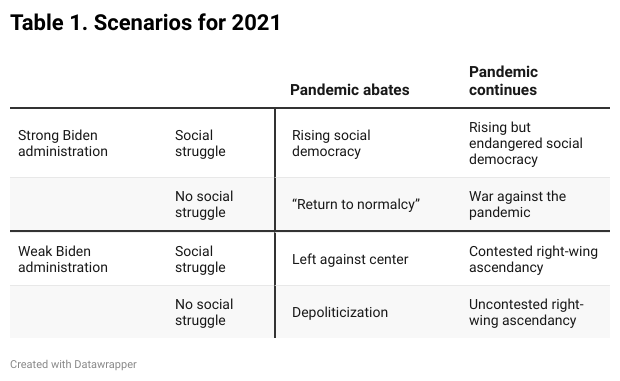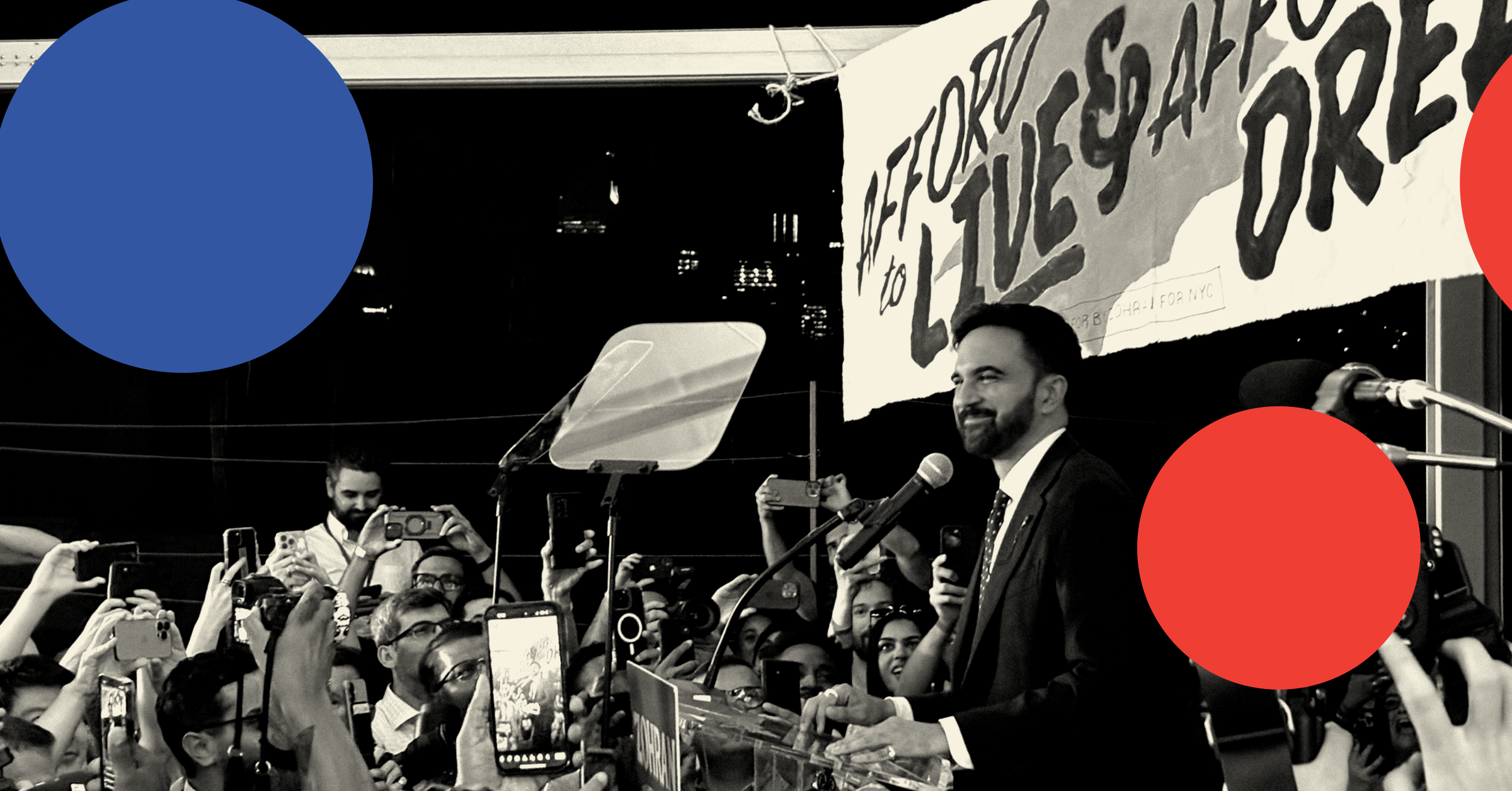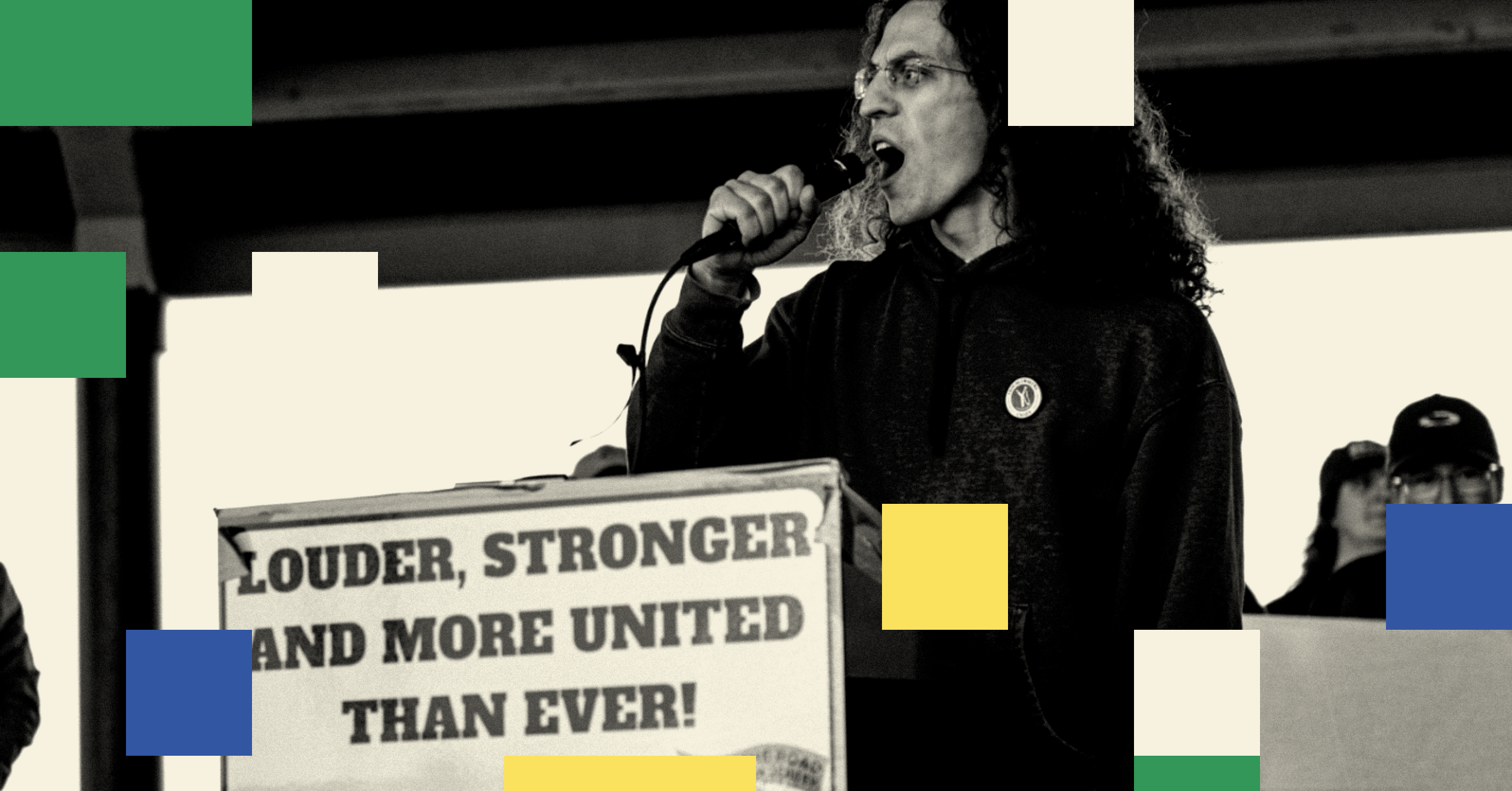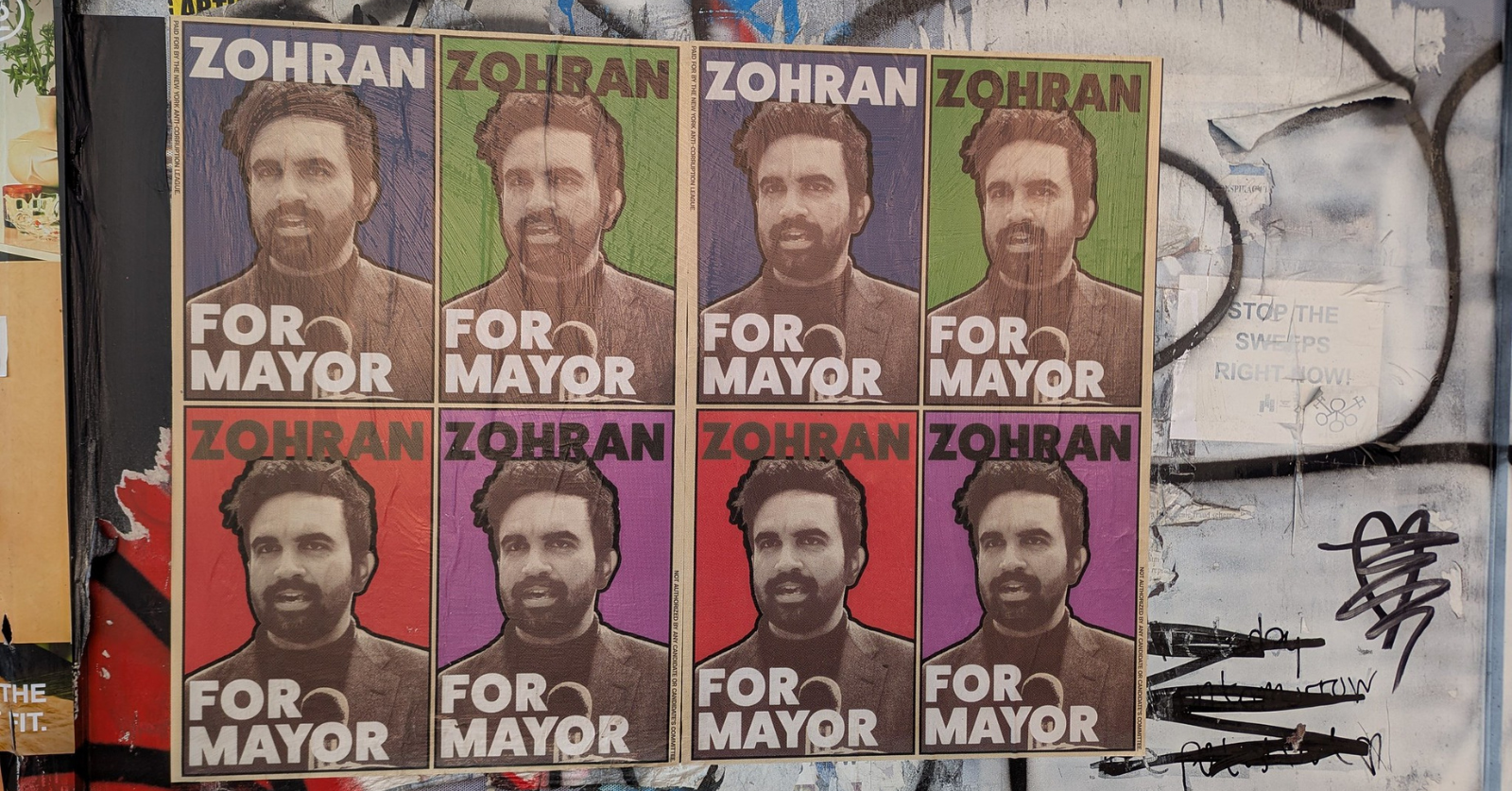In the depths of the worst surge to date last December, it was possible to feel hopeful about the coming year.
New vaccines seemed to promise a gradual end to the pandemic. Donald Trump and the Republicans had been defeated (though narrowly). Joe Biden’s incoming administration seemed to many to be committed to enacting a new New Deal. Following the massive Black Lives Matter rebellion of 2020 and the assurances of major climate organizations that the coming year would be one for movement building, prospects for renewed social struggle seemed promising.
Twelve months later we can draw up a balance sheet: The pandemic rages on. Biden’s weak and ineffective administration is almost as unpopular as Trump’s was at its termination. With the glimmering exception of a flurry of strikes and union democracy fights in October and November, 2021 brought no new round of social struggle. And only the right stands to gain — licking its lips at the prospect of new victories that, combined with a plan to further rig elections, could cement its control on American politics for a long time to come.
What went wrong?
The Pandemic
The basic trajectory of the pandemic over the last year hardly needs repeating. The rollout of vaccines was slow to start but gradually picked up pace through the spring. A couple of comparatively carefree months of flatlining cases followed. The worst of the pandemic — at least for the vaccinated — seemed to be over.
But then things went belly up.
The Biden administration and governments in other major western countries made little effort to vaccinate the Global South, especially in Africa. Eager to protect the profits of major vaccine developers, patents were not lifted and free vaccines were never distributed across the world. This created the perfect breeding ground for new mutations of the virus. Delta and Omicron have returned to ravage the South and North alike.
Conditions were also created to make a new surge more likely. In May, the CDC and the administration cheerily announced that vaccinated people would not need to wear masks inside any longer. They could forgo testing even if they were exposed. In the summer, a major producer of rapid Covid tests destroyed a large portion of its supplies and laid off workers to protect its profits. And just weeks ago, as the latest surge began to gather pace, the White House mocked the idea of distributing free tests.
To make matters worse, the Biden administration has leaned into turning the pandemic into a culture war. In a recent statement addressing the unvaccinated, the administration announced: “[Y]ou’re looking at a winter of severe illness and death for yourselves, your families, and the hospitals you may soon overwhelm.”
Now cases are rising to unprecedented heights. Testing capacity has been overwhelmed in major cities.
And there’s no end in sight. The Biden administration continues to refuse to help make vaccine recipes available to the Global South. New variants surely lurk on the horizon.
A Weak Administration
Expectations for Biden’s new government were set high. According to many progressive commentators, he was supposed to bring a new New Deal. A major push to stop climate catastrophe. Redistribution to right the wrongs of the Age of Inequality.
And it wasn’t just outsiders alone who were gassing up the incoming administration in this way. “Biden’s been very clear: To get back to where we were sets the bar way too low,” asserted Jared Bernstein, a newly minted member of Biden’s Council of Economic Advisors. “Much like FDR faced a structural crisis of economic insecurity, we’re at a similar place.”
Biden himself declared that the times were “not unlike what happened in 1932.”
A few weeks before the inauguration, Senator Ed Markey, a progressive Democrat, announced on Twitter: “The age of incrementalism is over.” (Sunrise Movement then quote-tweeted him and announced that “The Decade of the Green New Deal has just begun.”)
Some on the socialist left even began to question how subordinate Biden and the Democratic Party really were to the capitalist class.
But reality steamrolled those hopes.
It’s hard to say what those in the Biden government, in their heart of hearts, really wanted to do in 2021. There’s good reason to think that many did want to “go big” and pass a package to lift the incomes and security of Americans on the bottom and in the middle and to rebuild the social safety net. But if there’s one thing we should learn from this year it’s that intentions in politics sometimes count for very little. It’s strategy and economic and social conditions that matter most.
And on the question of strategy the Biden administration was unwilling or unable to break with its party’s past. That hobbled its efforts from the get-go, and made the administration a profoundly weak one.
The Democrats’ strategy looked something like this:
First, build a coalition for their agenda in the business world.
Then, leverage that coalition’s connections to Democrats and Republicans alike to try to amass legislative majorities.
And finally, negotiate in good faith with recalcitrant Democrats.
The method worked in the spring. Desperate for another “priming of the pump,” the business class practically begged the administration to pass its American Rescue Plan. On a party line vote, Democrats pushed it through Congress.
But the wheels on the operation fell off at every step after that.
No business coalition was forthcoming for the president’s much more ambitious Build Back Better Act. The Act would create a universal preschool program, cut the costs of childcare in half, extend the Child Tax Credit program, juice the transition to renewable energy, and slash the costs of healthcare.
While the business world was not necessarily opposed to any of these objectives, it steadfastly refused to pay for them. As a New York Times headline and blurb put it succinctly: “In social policy bill, businesses see a lot to like. [But] they oppose it. Resistance to tax increases outweighs the appeal of a $3.5 trillion measure containing child care credits and other items that corporations embrace.”
Without a business coalition at their back, and allergic to the prospect of turning to unions and social mobilization to build pressure, Democrats then tried but failed to rally their caucus on their own. Joe Manchin, Kyrsten Sinema, and other conservative Democrats were the most vocal of the resistance to Build Back Better. Ambitions were scaled back significantly to placate them, but to no effect.
As negotiations went south, Democrats refused to turn up the heat on their party’s right wing. Rather than tie the bipartisan infrastructure package (a corporate slush fund which Manchin and other right-wing Democrats actually wanted to pass) to Build Back Better, Biden and leading Democrats worked overtime to twist the arms of gullible progressives. They eventually succeeded in convincing progressives to decouple the two bills (the “Squad” including AOC and Rashida Tlaib were the only Democrats who opposed this step). And then, having surrendered any leverage — and even after Manchin announced he would not support Build Back Better — leading Democrats spent their time and energy policing the party’s left wing for criticizing him.
The end result has been paralysis and plummeting support. An administration that came in promising to break with the past has relatively little to show for its first twelve months in government. Biden’s approval rating hovers in the low 40s, Democrats were clobbered in the off-year elections in November, and no one in the party looks optimistically to next year’s midterms.
Grounding Social Struggle
Things didn’t go much better in the world beyond D.C. either.
Major social movement organizations were confident that the incoming administration had a serious and winnable strategy. They went all in on grassroots lobbying to try to help shape the agenda. Tactics that might imply that movements and the Biden administration held contradictory interests and were not on the same page — occupations, mass street protests, marches on D.C., coordinated strikes — were never considered.
That wasn’t always the case. The Sunrise Movement seemed to initially focus its energies on playing the inside game in D.C., but by the summer had turned towards more confrontational protests, some directly attacking Biden’s administration (a protest in June featured some signs saying “Biden, You Coward, Fight For Us”). But the energy (and the media attention that comes with it) was not there.
Nor has there been much success in revitalizing the rebellious energy of last year’s Black Lives Matter protests. Leading members of the diffuse movement are left to complain that they lack the access to the administration that they expected.
Why the demobilization after a few heady years of protest during the Trump administration? We are living through only the most recent iteration of an ongoing pattern: mass mobilizations during Republican administrations drop off as soon as Democrats are elected. Progressives, union activists, and movement organizers line up behind Democrats not only during campaigns but afterwards, celebrating them as progressive champions. In one instance, progressive and left-wing Democrats in spring 2021 went on a push to tell the press just how great Biden was. It’s hard to build a movement against a Democratic administration when respected left-wing leaders are insisting that the president is an ally. We’ll be stuck in this pattern until a much broader left acknowledges the nature of capitalism and the Democratic Party, sets our sights higher, and adjusts our strategies accordingly.
The one bright spot has been in labor: an upsurge in strikes this past fall and prospects for a renewal of militancy in two important unions, the Teamsters and the Auto Workers. The number of strikes in 2021 reached the low triple digits, a first in at least the last five years. And strikes are finally spreading beyond the education and healthcare sectors to factory and other blue-collar workers. But as others have pointed out, October and November were hardly the strike wave that they were initially made out to be, as far fewer workers went out on strike this year than in either 2018 or 2019. Moreover, the rank-and-file votes against incumbents in the Teamsters and UAW were achieved with low member turnout and will need far more work to turn into real movements.
Nor has the strike energy received much support from labor leaders. Caught unaware — and in some cases caught negotiating contracts that their more rebellious rank-and-file members then bravely rejected and struck against — conservative union leaders have predictably refused to fan the flames of a labor rebellion.
What Is and What Could Have Been
If we were gaming out the possible scenarios for 2021 in December of last year, the options might have looked like the following, ranked in order of how beneficial they would have been for the Left. (I find the ones involving a strong Biden administration hard to imagine, given the subordinate position of the administration and the Democratic Party to capital — an issue I’ve written about before. Though perhaps with strong and antagonistic labor and social movements the administration could have been pressured into taking a more assertive approach than it did.)

- The “rising social democracy” scenario: In many ways, the best we could have hoped for. A strong Biden administration shoved into action by social movements and gaining some independence from business relies on labor and mobilizations to push through its agenda. It hits predictable walls with right-wing Democrats. But it fights them tooth-and-nail and goes into 2022 as the underdog looking to expand its majorities in Congress. Social struggles shake up D.C. and beyond, championing popular demands that expand the base for progressive and left-wing politics. The Left grows stronger and is seen by many to be the best champion for redistribution and social transformation. The pandemic abates, to everyone’s relief, and allows the country’s full attention to turn to expanding social welfare and rewriting the social contract.
- The “left against the center” scenario: The second best. A weak Biden administration, adamant that it will not challenge the interests of its base in the business world, is confronted by renewed social struggles led by labor, Black Lives Matter, the climate movement, and others. Growing numbers of working people come to see the limits of the Democratic Party’s strategy and turn leftward. The pandemic abates.
- The “rising but endangered social democracy” scenario: Third best. A strong Biden administration pushed by intense social struggle fights to rewrite the social contract. But the pandemic rages on, jeopardizing the focus on passing a new redistributive program.
- The “contested right-wing ascendancy” scenario: Fourth best. A weak Biden administration and a raging pandemic whittle away at Democrats’ popular support, but renewed social struggle allows the Left to chart an independent path. The right grows stronger as the Democrats’ support falls, but the right’s ascendant position is challenged by new popular forces.
- The “return to normalcy” scenario: Fourth worst. A strong Biden administration goes unchallenged by social movements and carries out a mild center-left program. The pandemic abates, tensions defuse, and everyone who can afford it goes back to brunch. Biden’s mild successes deny the right much momentum.
- The “depoliticization” scenario: Third worst. A weak Biden administration, no social struggle, but the pandemic abates. People’s interest in politics begins to flag, and the country returns to its 2015 self. The right skulks on the sidelines.
- The “war against the pandemic” scenario: Second worst. The pandemic rages on, but Biden puts together a strong administration. Social struggles are absent, so Democrats focus all their attention on trying to snuff out the pandemic.
- The “uncontested right-wing ascendancy” scenario: The worst. The pandemic rages on, a weak Biden administration is powerless and/or unwilling to take the necessary steps to stop it, and low levels of social struggle mean that the administration pursues its default strategy of courting business and fails to enact meaningful reforms. The far right is ascendant once more and grows stronger. Former norms of democracy in politics are flouted.
The year 2021 went about as badly as it could have gone because we lived through that last scenario. A weak Biden administration, a prolonged and unchecked pandemic, and low levels of social struggle mean that the right is once again in the driver’s seat, mass death is an ever-present reality, and the Left has gained very little strength in the interim.
One can’t do politics from a position of pessimism. Antonio Gramsci’s command that we marry “pessimism of the intellect” with “optimism of the will” is as relevant as always. We can’t predict what 2022 holds in store. We go into the new year ready to fight, to build our forces, to lay the seeds for transforming our unions, and to win more and more people over to socialism.
But we can’t craft strategy in a reality-free zone, either. The last two years have been bad, very bad. Opportunities were squandered and our enemies are growing stronger. That’s the truth we have to confront. Now it’s time to fight to make sure 2022 looks very different.




